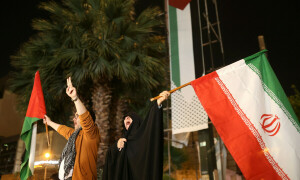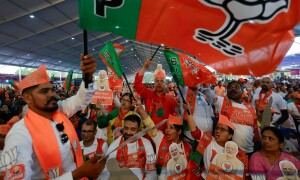The Food and Agriculture Organisation (FAO) defines forest as land with tree crown cover (or equivalent stocking level) of more than 10 per cent and an area of more than 0.5 hectare. As a rule, 25pc of a country’s area should consist of forest cover. But in Pakistan, it is about 5pc or 4.34 million hectares of the country’s land area.
However, according to the World Bank sources, the total forest area of Pakistan was 3.3pc back in 1990, which has fallen to an alarming 1.9pc by 2015. In total, between 1990 and 2015, Pakistan lost 24.7pc of its forest cover, or around 625,000 hectares. The country is 110th globally in terms of the percentage of land covered by forests. The deforestation rate in the country, estimated at 0.2-0.5pc annually, is the highest in the world, which accounts for a 4-6pc decline in wood biomass per annum.
According to an International Union for Conservation of Nature (IUCN) report, Pakistan’s forests may die out within the next 10 to 15 years if the present rate of deforestation continues.
The main causes of deforestation are: demographic pressure, illegal cutting of trees, poor management of forests, household dependency on fuel wood for cooking etc. An increase in salinity due to sea water intrusion along the coastline of Sindh and Balochistan has adversely affected mangroves. Between 1965 and 2001, the area under mangroves has decreased from 400,000 hectares to 158,000 hectares. Juniper forests of Ziarat, known as living fossils, are declining at the rate 1.27pc per annum.
From the air we breathe to the wood we use, we depend on forests for our survival. Besides providing habitats for animals and livelihoods for humans, forests offer many benefits, such as watershed protection, prevention of soil erosion, mitigation of climate change by carbon sequestration, and provision of wood as a substitute for fossil fuel. Afforestation can also support side businesses, like apiculture, sericulture and livestock. It can even be a good source of herbal drugs.
Urban forests can play a key role in making cities more resilient to the effects of climate change. They offset industrial and agricultural pollution. Trees can cool cities by between two degrees Celsius and 8°C. When planted near buildings, trees can cut air conditioning use by 30pc and reduce the heating energy use by a further 20-50pc. One large tree can absorb 150 kilograms of carbon dioxide in a year and can produce as much oxygen as 10 people inhale in a year.
Research studies have shown that an individual tree can provide net benefits of up to $50 per year. All these benefits can be availed if the planted tree reaches the age of 10 years. As part of the United Nations Collaborative Programme on Reducing Emissions from Deforestation and Forest Degradation in Developing Countries – a new mechanism of paying cash credit to developing countries that protect forests and the carbon stored within them – Pakistan can earn between $400m and $4 billion per year by conserving forests.
Wastewater from cities is largely used for growing vegetables and fodder, which poses serious environmental and health issues. This wastewater can be safely used for afforestation and will provide water re-use and nutrient recycling opportunity.
The World Conservation Union has estimated that with the current population growth, wood consumption in Pakistan would increase by 3pc every year. Increasing 1pc area under forests will require afforestation on 1.05m hectares. To achieve the benchmark of 25pc forest cover, we have to plant trees over an area of 15.56m hectares in addition to the existing forests. About 1,000 to 2,500 trees of species with upright growth habit or 500 to 1,000 spreading crown trees can be grown in one hectare. Assuming an average tree density of 500 per hectare, it would mean growing 7.78 billion trees.
Currently, plants of different tree species are available in nurseries of the Punjab’s Forest Department for Rs8 per tree (Acacia) and Rs60 per tree (Jamun). Assuming an average price of Rs50 per sapling for the next five years, it would require an investment of Rs389bn for saplings only.
The achievement of this herculean task is only possible through a collective effort by the nation and participatory approach by the public and private sectors. The private sector should come forward to establish forest tree nurseries and provide saplings to the public at subsidised rates. Farmers can allocate 5-10pc of their farm area exclusively for growing trees like other field crops are grown. Tree species palatable to goats and sheep can provide additional benefit as fodder. Moreover, fodder crops can be intercropped in forest fields to feed the livestock. Farmers can sell these trees to meet their economic needs. Along the highways/motorways and around the cities, public land can be dedicated for raising trees and people should be mobilised to plant and take care of planted trees. Commercial organisations can include this afforestation activity in their corporate social responsibility projects.
Bringing more area under trees will not only help mitigate the environmental challenges, water scarcity issue and weather extremes, but will also contribute to the economic development of the country. We should not only gear our efforts to bring more area under forests, but also take care of the existing forests so that we can leave a green, healthy and prosperous Pakistan for our coming generations.
Dr Muhammad Abbas Aziz has a PhD in soil science.
Rashid Manzur has a master’s in agriculture and has been working with government and private organisations for 33 years.
Published in Dawn, The Business and Finance Weekly, July 30th, 2018

















































Dear visitor, the comments section is undergoing an overhaul and will return soon.